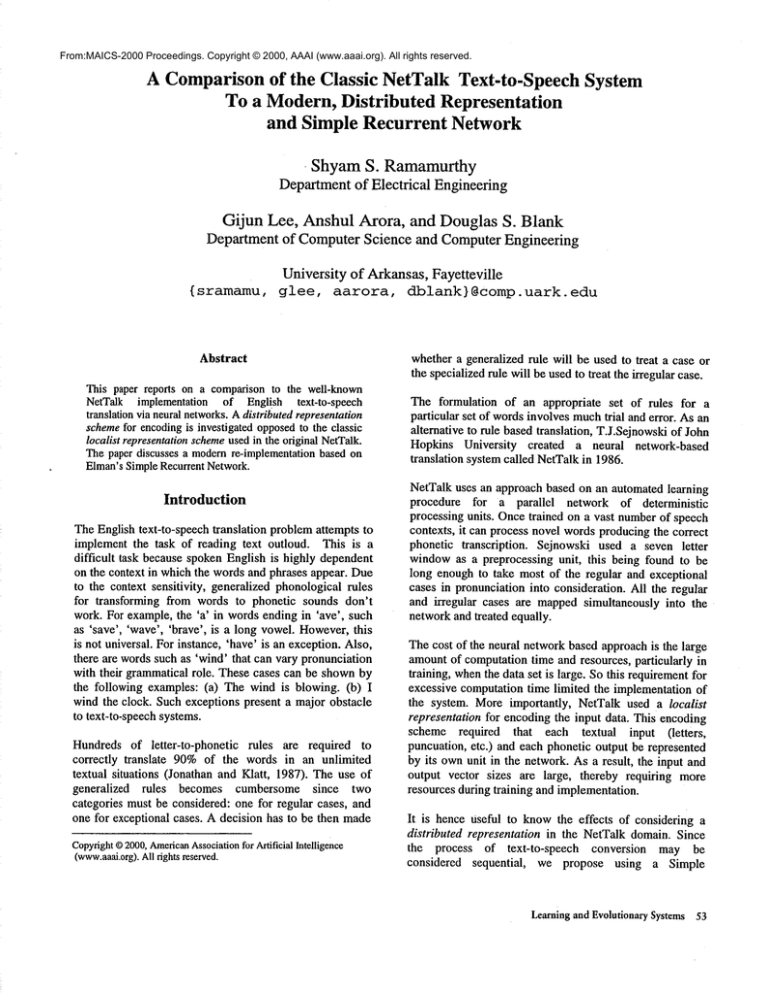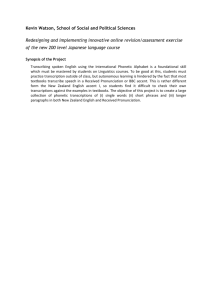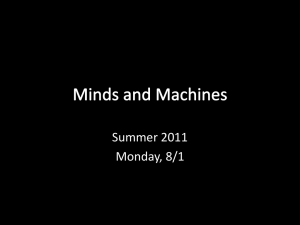
From:MAICS-2000 Proceedings. Copyright © 2000, AAAI (www.aaai.org). All rights reserved.
A Comparison of the Classic NetTalk Text-to-Speech
To a Modern, Distributed Representation
and Simple Recurrent Network
System
ShyamS. Ramamurthy
Departmentof Electrical Engineering
Gijun Lee, AnshulArora, and DouglasS. Blank
Departmentof ComputerScience and ComputerEngineering
{sramamu,
University
of Arkansas,Fayetteville
glee, aarora,
dblank}@comp.uark.edu
Abstract
This paper reports on a comparisonto the well-known
NetTalk implementation of Engl!sh text-to-speech
translation via neuralnetworks.A distributed representation
schemefor encodingis investigated opposedto the classic
localist representationschemeused in the original NetTalk.
The paper discusses a modemre-implementationbased on
Elman’sSimpleRecurrentNetwork.
Introduction
The English text-to-speech translation problemattempts to
implement the task of reading text outloud. This is a
difficult task because spoken English is highly dependent
on the context in which the words and phrases appear. Due
to the context sensitivity, generalized phonological rules
for transforming from words to phonetic sounds don’t
work. For example, the ’a’ in words ending in ’ave’, such
as ’save’, ’wave’, ’brave’, is a long vowel. However,this
is not universal. For instance, ’have’ is an exception. Also,
there are wordssuch as ’wind’ that can vary pronunciation
with their grammatical role. These cases can be shownby
the following examples: (a) The wind is blowing. (b)
wind the clock. Such exceptions present a major obstacle
to text-to-speech systems.
Hundreds of letter-to-phonetic
rules are required to
correctly translate 90%of the words in an unlimited
textual situations (Jonathan and Klatt, 1987). The use
generalized
rules becomes cumbersome since two
categories must be considered: one for regular cases, and
one for exceptional cases. A decision has to be then made
Copyright
©2000,American
Association
for ArtificialIntelligence
(www.aaai.org).
Allrightsreserved.
whether a generalized rule will be used to treat a case or
the specialized rule will be usedto treat the irregular case.
The formulation of an appropriate set of rules for a
particular set of wordsinvolves muchtrial and error. As an
alternative to rule based translation, T.J.Sejnowskiof John
Hopkins University created a neural network-based
translation system called NetTalkin 1986.
NetTalk uses an approach based on an automated learning
procedure for a parallel network of deterministic
processing units. Oncetrained on a vast numberof speech
contexts, it can process novel words producing the correct
phonetic transcription. Sejnowski used a seven letter
windowas a preprocessing unit, this being found to be
long enough to take most of the regular and exceptional
cases in pronunciation into consideration. All the regular
and irregular cases are mappedsimultaneously into the
networkand treated equally.
The cost of the neural networkbased approach is the large
amountof computationtime and resources, particularly in
training, whenthe data set is large. So this requirementfor
excessive computation time limited the implementation of
the system. More importantly, NetTalk used a localist
representation for encoding the input data. This encoding
scheme required that each textual input (letters,
puncuation, etc.) and each phonetic output be represented
by its ownunit in the network. As a result, the input and
output vector sizes are large, thereby requiring more
resources during training and implementation.
It is hence Useful to knowthe effects of considering a
distributed representation in the NetTalk domain. Since
the process of text-to-speech
conversion may be
considered sequential,
we propose using a Simple
Learningand EvolutionarySystems53
Recurrent Network (SRN, Elman 1990). A SRN based
implementation can reduce the input vector size further
and is expected to yield a better performancethan the feedforward network implementation used by NetTalk.
In the following sections, the NetTalk system is first
described. This is followed by a description of the
modified implementation. The results of our experiments
are then reported. Finally, the conclusions and the scope
for future workis presented.
Description of the NetTalksystem
The NetTalk data set contains a list of 20,008 English
words, along with a phonetic transcription for each word.
The task is to train a network to produce the proper
phonemes,given a string of letters as input. The data file
represents each word in the form shown below for the
word "abbreviate" (see Figure 1). Corresponding to each
word, a pronunciation code and an accent code is listed.
Textual
Input
a
b
b
r
e
v
i
a
t
e
=>
=>
=>
=>
=>
=>
=>
=>
=>
=>
Phonetic
Ouput
x,
b,
-,
r,
i,
vt
i,
et
t,
-t
Stress
O;
<;
>;
>;
I;
>;
O;
2;
<;
<;
Figure 1: The word ’abbreviate’ in the NetTalkdata
representation. Column1 showsthe textual input, column
2 the phonetic output, and column3 the stress level for that
phoneme.See text for details.
Even though a certain letter in a word might not produce a
sound, NetTalk maps the alphabet to a pronunciation
symboland accent. For instance, Figure 1 showsthe actual
data used in NetTalk for the work "abbreviate". The first
columnhas English letters; the second column, the actual
pronunciation; and the third column,accent and intonation.
For example, the first ’a’ in the word abbreviate can be
mute or could be pronounced like very weak ’uh,’ and
therefore, mappedto that phonemerepresented by ’x’.
The second ’b’ in the word does is not pronouncedbecause
of the first ’b’. So, the second ’b’ is mappedto the ’-’
symbol, which means that it is not uses in the
pronunciation.This also applies to the last ’e’. In the third
column, you can see three numbers and the less-than and
54 MAICS-2000
greater-than symbols. NetTalk maps every vowel to one of
these accent symbols.If a vowelgets a primaryaccent, it is
marked as a two. If a vowel is marked as a secondary
accent, it is represented as a one, and zero meansalmost no
accent. For intonation, ’>’ and ’<’ are used. ’>’.
The training input to the network is a series of seven
consecutive letters from one of the training words. The
central letter in this sequenceis called the "current" one
for which the phonemicoutput is to be produced.
Threeletters on either side of this central letter providethe
context that helps to determine the pronunciation. There
are a manycharacters in the English alphabet for which
this local seven-letter windowis sufficient to determinethe
proper phonemic output. For the study using this
"dictionary" corpus, individual words are movedthrough
the windowso that each letter in the word is seen in the
central position. Blanks are added before and after the
word as needed (see Figure 2). Somewords appear more
than once in the dictionary, with different pronunciations
in each context; only the first pronunciation given for each
word was used in this experiment.
NetTalk uses a localist encoding. For each of the seven
letter positions in the input, the networkhas a set of 29
input units: one for each of the 26 letters in English, and
three for punctuation characters. Thus, there are 29 x 5 =
203 input units in all. The output side of the networkuses a
distributed representation for the phonemes.There are 9
output units representing various articulatory features such
as voicing and vowel height. A distinct binary vector
represents each phonemeover a set of 29 units (see Figure
3).
Standard back-propagation was used, with update of the
weights after the error gradient has been computed by
back-propagationof errors for all the letter positions in a
single word. The number of hidden units in the network
was varied from one experiment to another, from 0 to 120.
Eachlayer was totally connectedto the next; in the case of
0 hidden units, the input units were directly connected to
the outputs.
The network weights were initialized
in the range -0.3 to +0.3.
with randomvalues
The modified implementation
We then used a reduced data set consisting of 500
commonlyused words as the basis of our experiments.
This reduced data set was comparedwith the NetTalk data
At the output, we used a 9-bit distributed encoding. Out of
the 9-bits, 6 (64 cases) are for the pronunciation code and
3 (8 cases) for the accent code.
!
Pronouncecharacter at [
this position
This encoding resulted in more than 1800 patterns for the
data set used. First, a feed-forward neural network was
implementedin the Con-x backpropagation system (Blank,
1999) with 35 units at the input layer and 9 units at the
output layer. The performance of this network was tested
for 20, 40 and 80 units at the hiddenlayer.
¯
I-I-I-lelxlclel
1
This encoding scheme was then tested using a SRN
(Elman,1990). In the case of the SRN,the numberof units
in the input layer was reduced to 20. This is because the
input layer has only 4 positions consisting of the current
Figure 2. Illustrates the encodingof the wordusing the 7- character for which the pronunciation is to be produced
and 3 leading characters. Each character requires 5 units
character window.
for the distributed representation at the input (see Figure
4). The performance of this network was tested on the
same data set for 20 and 40 units in the hidden layer. The
numberof units in the context layer was set the same as
the hiddenlayer.
II lelxiclel’t "
-
-
26units
Word
moves
OI otrrPtrr
IO O
LAYER
T
20, 40, 80, [ O OO O,~ ............
120 units
T
In the SRNimplementation, the activations from the
hidden layer were copied to the context layer whenever
there were characters preceding the character in the
pronunciation position. In the absence of any characters,
the activations at the context layer wereset to 0.5.
O[ HIDDEN
LAYER
The ability of the SRNto discover generalizations in this
problem lies in three primary components of the model.
First, the sequential presentation of words encoded as
binary vectors provides an reduced data set that only
contains implicit information about the relationships based
on the adjacency of words in the training set. Second,
209units
LAYER architectural constraints of the SRNsuch as the recurrent
combination of each input vector with the hidden-unit
Current ¢
activations from the previous time step provide a
compressed representation of the sequence of inputs.
I
Third, in order to solve the non-deterministic prediction
Figure 3. Feed-forward network structure used by NetTalk
task, the modelis forced to form a distributed memory
that
is based on the similarity structure of the compressed
sequencerepresentations. It is this similarity structure in
hidden unit space that reflects the lexical classes of the
file and 418 matching words were picked and used. Out of
words (Elman 1990).
these 418 words, 400 were used for training the network
and 18 randomly chosen words were used for testing the
network. These18 wordsresult in about 50 patterns due to
Results
encoding.
/
Iooolo
......t.....ol
Initially, we tried replicating the original NetTalksystem,
but with a slightly different input representation. The
encoding used as input consisted of 5-bit binary numbers
(thus allowing for 32 possible cases at each input) for each
of the locations. Weused a 7-character windowas in
NetTalk. Thus, we need only 5 X 7=35 units at the input.
The results of the implementation using the feed-forward
network and the SRNare described below. For comparison
purposes, the results achieved by NetTalkon the full dataset of 20,008 words with more than 140,000 training
patterns is also described.
Learningand EvolutionarySystems55
]0
[
0
0
0
O0
0..00!
0
O0
01
the hidden layer on the reduced data set. Thus, our
smaller distributed representation performed slightly
worse than the original NetTalk. This can be explained
(at least in part) to the reducedtraining set size.
9units
The SRNimplementation with 20 units in the input layer
and 9 units in the output layer resulted in a 90%match
with the test cases for 20 units in the hidden layer and
100%match for 40 units in the hidden layer. Again, we
have used a distributed (non-orthogonal) encoding at the
input as well as the output. In this case, althoughwe used
the samedistributed representation as before, due to the
recursive network structure we were able to out-perform
the original NetTalkperformance.
20and
40 units
Io-ooo[ Ioo o o o o ol
20 units
Conclusions
I-I-I-
elxlc le ’
I-I-lelxlclel’[
I
I
Word
moves
I
The current character and the 3 leading characters ]
are encodedand presented at input layer.
I
and Future work
These results indicate that it is feasible to use a
distributed (non-orthogonal) representation for this
problem. As a result, the numberof units can be reduced
leading to advantages in the implementation. The SRN
based implementationindicates that this approach can be
applied successfully for this application leading to
possible reduction in input windowsize or possibility of
more inputs from the leading characters. In these
experiments, we have used a significantly reduced data
set. The set of words used reflects the most commonly
used words. The implementation has illustrated
the
feasibility
and power of the SRNapproach. Further
experiments on larger data sets and with contexts of
complete sentences should be done to get a better
comparisonand reach firm conclusions.
Figure 4: SRNComparision
References
For the feedforward network, the original NetTalk
implementation used 209 units in the input layer and 26
units in the output layer. As detailed before, the encoding
was localist (orthogonal) at the input and distributed at the
output. For the full data set, this resulted in an 82 %match
with the test cases for 20 units in the hidden layer and a
98%match with 120 units in the hidden layer. In our
feedforward network implementation, we use 35 units in
the input layer and 9 units in the output layer. Wehave
used distributed (non-orthogonal) encoding at the input
well as the output. This resulted in a 70%match with 20
units in the hidden layer and a 93%match with 40 units in
56 MAICS-2000
Blank, D.S., (1999). Con-x: Connectionist Backprop
Language and Simulator User’s Manual.
http : //dangermouse.
uark. edu/cx/
Eiman, J. 1990. Finding Structure in Time, Cognitive
Science.
Jonathan, A., and Klatt Dennis, K. 1987. FromText To
Speech: The MITalk system. CambridgeUniversity Press.
Sejnowski,T. J. 1986. NetTalk: A parallel networkthat
learns to read aloud.



